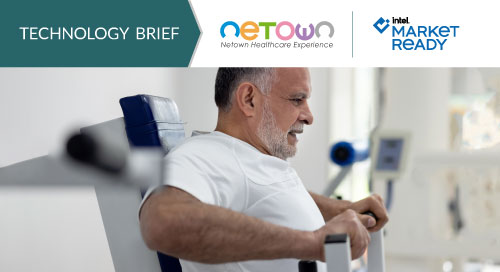Fill form to unlock content
Error - something went wrong!
Stay up-to-date with the latest IoT news.
Subscribed.
Smart Health Solutions: A New Model for Eldercare

An aging global population requires a new way of thinking about healthcare. There is an urgent need for eldercare medicine to shift away from simply treating illness, and to focus more on improving seniors’ overall health and well-being to enhance their quality of life.
One effective way to do this is through a daily exercise regimen designed to increase muscle strength and prevent functional degeneration due to muscle loss. But such programs are difficult to implement. They require a high degree of personalization and supervision to ensure safety and progress.
Sometimes this means self-guided exercise routines are not effective—either because they aren’t tailored to the individual, or because the exercises are being performed incorrectly. “We’ve heard from many physicians who are frustrated by this,” says Patricia Lin, Project Manager for Netown, a manufacturer of AI-enabled smart health solutions. “A doctor will give an elderly patient an exercise program to do on their own, but when they return for their follow-up appointment, they’ve actually gotten weaker.”
Healthcare providers find themselves in a difficult situation, since in an era of medical staffing shortages, it’s just not feasible to personally supervise their patients’ workouts. But recent advancements in IoT and edge AI have given rise to smart exercise solutions that address these challenges.
With #IoT in #healthcare, #EdgeAI, and interactive digital displays, smart exercise solutions are a game changer for personalized, senior healthcare. Netown via @insightdottech
IoT and Edge AI Enable Smart Healthcare Solutions
Smart health solutions help seniors exercise effectively without the involvement of a doctor, nurse, or personal trainer.
At first glance, these solutions may resemble ordinary exercise machines. For example, Netown’s Babybot Smart Exercise Series, a health kiosk and data control hub that enables networked exercise devices, comprises eight different pieces of weight training equipment that work different muscle groups. They’re similar to what one would find in any commercial gym, but engineered for lighter loads and gentler exercises.
And with IoT in healthcare, edge AI, and an interactive display as the user interface, smart exercise solutions are a game changer for personalized health and senior healthcare.
The system is designed to provide a personalized experience and facilitate individual data tracking. Users log in using a unique ID such as an RFID card or QR code, and are given a simple-to-follow video tutorial that shows them how to exercise. They receive feedback and encouragement via the interactive interface.
IoT sensors measure the amount of force produced by the user, as well as the speed of their motions. Edge AI uses this data to calculate the person’s muscle strength. During the first session, this helps to set a baseline to create a personalized training plan. In subsequent workouts, the system automatically adjusts the difficulty of the exercises in real time to build strength. The AI can also determine if a someone is performing the movement improperly or unsafely, offering correction and suggestions as needed (Video 1).
Despite their familiar appearance, these are complex, technologically advanced solutions. For this reason, Netown’s technology partnership with Intel has been particularly valuable. “Intel processors are extremely well suited to edge AI and real-time processing workloads,” says Lin. “The Intel® OpenVINO™ Toolkit helps as well, since the AI model was already there to leverage. We only needed to train and fine-tune it, which significantly shortened our development time.”
Improved Strength, Greater Independence
For senior citizens, smart exercise equipment is an effective means of maintaining health and mobility—or even regaining lost independence. Netown’s experience with a community fitness center in Taiwan offers an example of how this works in practice.
In this case, an 85-year-old man suffering from a profound loss of strength and mobility was referred to the fitness center.
Ordinarily, such a patient would be a candidate for closely supervised physical therapy. But Taiwan’s overstretched healthcare system was a part of the challenge in this case, since medical personnel at public hospitals and physical therapy centers are chronically overwhelmed.
Because Netown had already deployed its Babybot solution at the fitness center, the patient was able to follow a guided exercise program right in his own community. He began using the smart exercise equipment regularly, following instructions provided by the interactive UI. He found encouragement in the gamified incentive system: a ranking chart that let him measure his progress against other Babybot users, adding a bit of friendly competition to the experience.
The results were remarkable. After only three months, the man’s lower limb strength increased by 76.5%. But those numbers, while impressive, can’t fully convey the human element of story. The simple, day-to-day outcomes offered by smart health solutions are often the most meaningful, says Lin, “When elders are able to manage daily life by themselves, that’s real independence. It means everything to seniors and to their families. I’ll never forget the grateful look on the face of his grandchild when they were able to take a walk in the park together.”
A Healthier Future for Everyone
In the coming decades, smart health solutions will become increasingly relevant. Near term, the technology helps bolster health, independence, and quality of life for the world’s growing senior citizen population.
And beyond eldercare, there are promising use cases in other areas of medicine as well. “These solutions are going to be especially useful for long-term treatments like rehabilitation,” says Lin. “Physicians will one day be able to help patients do physical therapy in their own homes.”
The social value of smart health solutions is how they will help our world move toward a more expansive vision of health and well-being. In the future, getting stronger and preventing illness will take precedence over the mere detection and treatment of sickness—and people of all ages will have greater independence and control over their healthcare.
This article was edited by Georganne Benesch, Associate Editorial Director for insight.tech.